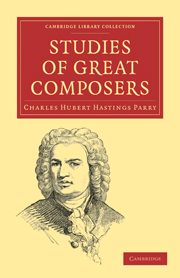I - PALESTRINA
Published online by Cambridge University Press: 29 August 2010
Summary
People often talk of music as the modern art, but it is not probable that they always realise clearly how very modern it is in the shape we know it. The sister arts, which comprise painting, and sculpture, and architecture, and decorative work of various kinds, can show masterpieces which still impress us as perfect and complete objects of beauty, though they were made or carried out more than two thousands of years ago. But if we go back as much as two hundred years in music, we feel as if we were among things in a crude and incomplete condition, like barbarous examples of the sister arts of races and nations even before history began. It seems indeed as if all other arts began with the beginnings of civilised life, but music came only with its well-advanced development.
The ancients had some sort of music, but it certainly was a very slight and unimpressive kind of thing; not calculated to please us much, or to move us at all. Such as it was, however, its system, and some of its actual melodies, lasted on through the dark ages between the collapse of the great states of ancient times, like Greece and Rome, and the days when modern states like Germany, France, and England were rising towards the condition they are in now. Something in the way of art of various kinds was just kept going in monasteries, and such places; where priests and monks lived together, and kept their intellects alive with study and work and interchange of ideas.
- Type
- Chapter
- Information
- Studies of Great Composers , pp. 1 - 21Publisher: Cambridge University PressPrint publication year: 2009First published in: 1887



